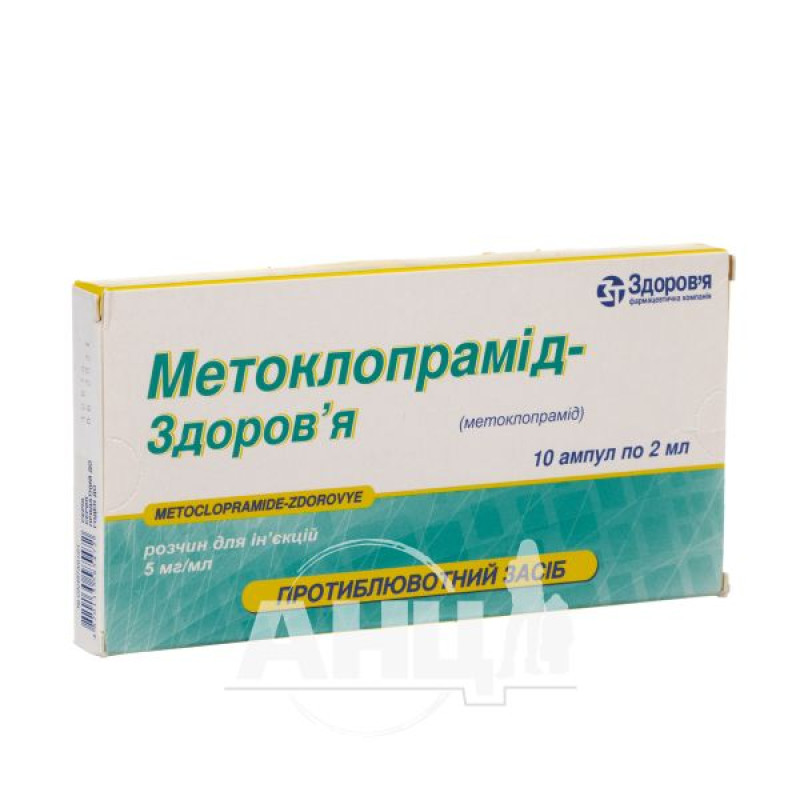Metoclopramide-Zdorovye solution for injection 0.5% ampoule 2 ml in blister No. 10

Pharmacological properties
Metoclopramide (4-amino-5-chloro-n-(2-diethylamino-ethyl) 2-methoxybenzamide) is a specific blocker of dopamine (d2) and serotonin (5-HT3) receptors, inhibits chemoreceptors of the critical zone of the brainstem, reduces the sensitivity of visceral nerves that transmit impulses from the pylorus and duodenum to the vomiting center. Through the hypothalamus and parasympathetic nervous system, it has a regulatory and coordinating effect on the tone and motor activity of the upper gastrointestinal tract. It increases the tone of the stomach and intestines, accelerates gastric emptying, prevents pyloric and esophageal reflux, stimulates intestinal peristalsis. It has a pronounced antiemetic effect in vomiting of various genesis (except vomiting of psychogenic and vestibular genesis). normalizes bile secretion, reduces spasm of the sphincter of Oddi without changing its tone, eliminates gallbladder dyskinesia. does not have m-cholinoblocking, antihistamine, antiserotonin and ganglioblocking effects; does not affect the tone of cerebral vessels, heart rate, respiratory function, as well as kidney and liver function, hematopoiesis, gastric and pancreatic secretion. stimulates the secretion of prolactin (like other dopamine receptor blockers). increases the sensitivity of tissues to acetylcholine.
After ingestion, it is quickly and completely absorbed. The maximum concentration in the blood plasma is reached 30-20 minutes after ingestion. The onset of action on the digestive tract is noted 1-3 minutes after IV administration and 10-15 minutes after IM administration. Bioavailability is about 5%. 13-30% of metoclopramide binds to blood plasma proteins. Metabolized in the liver. The half-life is 4-6 hours, in chronic renal failure it increases to 14 hours. Within 24-72 hours, up to 85% of the administered dose is excreted in the urine, about 30% in unchanged form. Penetrates the blood-brain barrier and the placental barrier, as well as into breast milk.
Indication
Nausea, vomiting of various genesis (caused by anesthesia, radiation and chemotherapy, toxemia, liver cirrhosis, migraine, traumatic brain injury, dietary disorders); motility disorders of the upper gastrointestinal tract (reflux esophagitis, gastroparesis of various etiologies, postoperative gastric atony, etc.); preparation for diagnostic examinations (gastrointestinal X-ray, gastroduodenoscopy, bronchoscopy, etc.).
Application
Taken orally before meals. Adults are prescribed 10 mg 3 times a day, if necessary, the dose can be increased.
In the acute period, it is administered intravenously or intramuscularly at a dose of 10-20 mg (contents of 1-2 ampoules) 1-2 times a day. In emetogenic chemotherapy with cisplatin, metoclopramide is administered 30 minutes before the administration of cisplatin, diluted in 50 ml of physiological sodium chloride solution, 5% glucose solution or Ringer's solution.
The maximum single dose for any route of administration is 20 mg, daily - 60 mg. The duration of treatment depends on the severity and course of the disease. Children over 6 years of age are prescribed 2.5-5 mg 1-3 times a day, for children under 6 years of age the maximum single dose is 0.1 mg/kg of body weight.
Contraindication
Hypersensitivity to metoclopramide, gastrointestinal bleeding, intestinal obstruction, perforation of the digestive tract, pigmentary and prolactin-dependent tumors, epilepsy, glaucoma, extrapyramidal disorders, Parkinson's disease, vomiting on the background of treatment or overdose with neuroleptics, vomiting in patients with breast cancer, I trimester of pregnancy, breastfeeding.
Side effects
Possible drowsiness, increased fatigue, headache, tinnitus, dry mouth, anxiety, restlessness, dizziness, allergic reactions (urticaria), constipation or diarrhea, gynecomastia and galactorrhea. Metoclopramide increases sodium retention and causes hypokalemia in patients with edema. With prolonged use, some elderly patients may develop parkinsonism (tremor, muscle twitching, limited mobility) and tardive dyskinesia.
Special instructions
It is used with caution in the treatment of patients with renal and hepatic insufficiency, with BA, AG. It is not prescribed after operations on the digestive tract. Against the background of the use of metoclopramide, false results of functional liver tests and determination of the concentration of aldosterone and prolactin in the blood plasma may be observed. During the period of treatment, one should refrain from driving vehicles and engaging in potentially dangerous activities that require increased attention and quick reaction. During the period of treatment, one should avoid drinking alcohol.
Interactions
When used simultaneously with anticholinergics, mutual weakening of the effect is possible. The drug reduces the absorption of cimetidine and digoxin, accelerates the absorption of antibiotics, paracetamol, lithium salts, acetylsalicylic acid, diazepam, ethanol and levodopa. In combination with phenothiazine neuroleptics and butyrophenone derivatives, the risk of developing extrapyramidal disorders increases. Enhances the effect of ethanol on the CNS, the sedative effect of hypnotics, the effectiveness of therapy with H2-receptor blockers.
Concomitant use with tricyclic antidepressants, MAO inhibitors and sympathomimetics is not recommended.
Overdose
Not described.
Storage conditions
In a dry place, protected from light, at a temperature not exceeding 30 °C.
There are no reviews for this product.
There are no reviews for this product, be the first to leave your review.
No questions about this product, be the first and ask your question.






